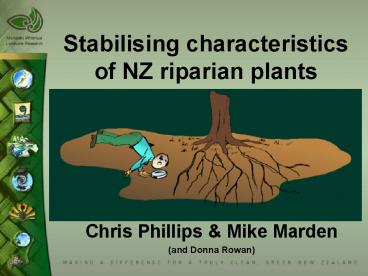Stabilising characteristics of NZ riparian plants - PowerPoint PPT Presentation
1 / 22
Title:
Stabilising characteristics of NZ riparian plants
Description:
Shading for instream plant control. Input of wood & leaf litter ... Ribbonwood Plagianthus regius. Kowhai Sophora tetraptera. Lemonwood Pittosporum eugenoides ... – PowerPoint PPT presentation
Number of Views:109
Avg rating:3.0/5.0
Title: Stabilising characteristics of NZ riparian plants
1
Stabilising characteristics of NZ riparian plants
Chris Phillips Mike Marden (and Donna Rowan)
2
Outline
- Set the scene
- The question
- What we did
- What we found
- What it means
- Summary
Grant Hunter
http//icm.LandcareResearch.co.nz/
3
Riparian functions
- Filtering of contaminants bugs, sed., nutr.
- Bank stabilization
- Nutrient uptake by plants
- Denitrification
- Shading for temperature
- Shading for instream plant control
- Input of wood leaf litter
- Enhancing fish habitat
- Controlling downstream flooding
- Recreation
- Aesthetics
4
The Issue
5
The cure-all?
6
The Big Question?
Can our New Zealand native plants perform a river
bank stabilising function as well as introduced
willows?
In geotechnical terms, how do we quantify the
benefits of vegetation to soil stabilisation?
7
2 strands of recent work
Riparian plant trial
Cabbage trees
Common name Botanical name Karamu Coprosma
robusta Ribbonwood Plagianthus
regius Kowhai Sophora tetraptera Lemonwood
Pittosporum eugenoides Kohuhu Pittosporum
tenuifolium Lacebark Hoheria populnea Mapou
Myrsine australis Fivefinger Pseudopanax
arboreus Cabbage tree Cordyline
australis Rewarewa Knightia
excelsa Manuka Leptospermum scoparium Tutu
Coriaria arborea
Czernin (2002)
Marden, Rowan, Phillips
8
Methods plant trial
- 10 plants / species/ age class 1 to 5 years
- 1 and 2 yr old plants from pots
- 3-5 yr old plants extracted from trial plot
- measured dbh, root collar, tree height, canopy
width - above-ground components - stem, branches
foliage - root system extracted intact - air lance
- below-ground - root bole (stump) roots
- roots diam. size classes measured for length
- all components oven dried and weighed
- tensile strength of roots tested
9
Root spread
Pittosporum tenuifolium (kohuhu)
Coprosma robusta (karamu)
10
Root spread 5 year old
400
350
300
(cm)
250
200
150
100
50
0
tutu
kowhai
mapou
karamu
kohuhu
five.finger
lacebark
rewarewa
manuka
ribbonwood
lemonwood
cabbage.tree
11
Results - root depth
12
Root depth 5 year old
ribbonwood
cabbage.tree
five.finger
lemonwood
lacebark
rewarewa
manuka
kohuhu
karamu
mapou
kowhai
tutu
0
5
10
15
20
(cm)
25
30
35
40
45
50
13
Root depth cabbage tree
11 yr
Czernin (2002)
Age
14
Biomass 5 year old
Above-ground
14
12
10
8
6
(kg)
4
2
0
2
4
tutu
mapou
kowhai
kohuhu
karamu
manuka
five.finger
lacebark
rewarewa
lemonwood
ribbonwood
cabbage.tree
Below-ground
15
Growth summary
Czernin (2002)
16
Root tensile strength
(1 - 4 mm diameter)
Willows 30 - 75 MPa
Watson Marden (submitted)
60
Riparian plant trial
50
40
Exotics
30
Mean max. tensile strength (MPa)
20
10
0
Rata
Tutu
Kanuka
Kamahi
Kowhai
Karamu
Kohuhu
Manuka-1
Douglas fir
Lacebark
Red beech
Hard beech
Manuka-2
Fivefinger
Rewarewa
Radiata pine
Ribbonwood
Lemmonwood
Cabbage tree
Mountain beech
17
Implications for bank stabilization - small
streams
- no limitations, provided that bank height is not
more than 2 m and channel bed is stable - success depends on density - formation of dense
canopy full root occupancy of the soil - shallow soil stabilisation after 3-5 years
- improvement in deeper slope stabilisation
expected within 7-10 years of establishment - species can withstand breakage and over-topple
18
Implications for bank stabilization - large
streams
- lack of roots in deeper soil layers limits
usefulness in streams where bank undercutting
occurs - ineffective if bank height exceeds effective
rooting depth 2 m. - banks would need to be graded and unstable
channel beds artificially regraded prior to
planting
19
(No Transcript)
20
Decisions?
Ecologically designed vs functional performance?
- Depth cabbage tree, ribbonwood
- Spread lemonwood, ribbonwood
- Above gd biomass cabbage tree, tutu
- Below gd biomass cabbage tree, tutu
- Tree height lacebark, ribbonwood, cab. tree
- Canopy spread tutu, karamu
- Root strength lacebark, kanuka, kohuhu
21
Summary
- NZ natives take longer to grow than exotics but
not slow - Some natives can regenerate, eg cabbage trees -
good - On own, natives not as good as willows for
stabilising soils - Effective after about 5 years
- Change the ecological mix to suit site
- Mixed plantings of natives and exotics?
- More work needed
- non-woody spp
- Mixed exotic/native
- modelling
22
The end
23
Species list and numbers extracted for
partitioning
Number of plants extracted /species/year
Common
Botanical name
Species
name
1
2
3
4
5
Total
Karamu
Coprosma
robusta
10
10
7
8
10
45
Ribbonwood
Plagianthus regius
10
10
10
10
10
50
Kowhai
Sophora tetraptera
10
8
8
8
10
44
Lemonwood
Pittosporum eugenoides
10
10
10
10
10
50
Kohuhu
Pittosporum tenuifolium
10
10
10
9
10
49
Lacebark
Hoheria
populnea
10
10
10
10
8
48
Mapou
Myrsine australis
10
10
10
10
10
50
Fivefinger
Pseudopanax arboreus
10
10
10
8
8
46
Cabbage tree
Cordyline australis
10
10
10
10
10
50
Rewarewa
Knightia excelsa
10
10
10
10
9
49
Manuka
Lep
tospermum scoparium
10
10
5
0
5
30
Tutu
10
10
10
8
5
43
Coriaria arborea
Annual totals
120
118
110
101
105
554
24
Pseudopanax arboreus (fivefinger)
Biomass































